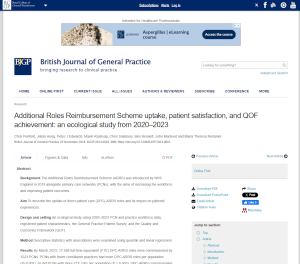Additional Roles Reimbursement Scheme (ARRS) associated with small improvements in patient satisfaction
26 November 2024
The Additional Roles Reimbursement Scheme (ARRS) is associated with a small improvement in patient satisfaction and perceptions of access, according to a new study published in the British Journal of General Practice (BJGP). However, the scheme did not improve outcomes in the Quality and Outcomes Framework (QOF).
University of Bristol researchers funded by the National Institute for Health and Care Research (NIHR) analysed Primary Care Network (PCN) and GP practice data. They found that roles under the scheme had increased rapidly. In March 2020 there were 280 full-time equivalent (FTE) staff in ARRS roles. By March 2023 this had leapt to 17,588 FTE roles commissioned by 1,223 PCNs. This was accompanied by a large increase in NHS spending on these roles from £110m in 2019/2020 to £1,027m in 2022/2023.
While the scheme predated the COVID pandemic, it was seen as one solution for the reset and recovery of the NHS.
ARRS introduced more non-GP health professionals, such as physiotherapists and paramedics, to GP practices. NHS England hoped to see a rapid rise in the number of these staff in primary care.
The scheme was designed to give patients better access to appointments, helping address the workforce crisis in primary care and ever-greater demand from patients. It aimed to expand and enhance the workforce, reduce pressure on GPs, create a more multidisciplinary approach to patient care and improve outcomes for patients.
The research team found employing one full time equivalent ARRS staff was associated with small increases in the number of patients ‘satisfied’ with their GP practice (0.8 per cent) and the number of patients reporting a ‘good’ experience of making an appointment (0.7per cent).
The QOF is a voluntary reward and incentive programme for GP practices. It rewards them for the quality of their care and helps standardise improvements. The ARRS roles did not seem to influence how practices fared in the QOF.
In terms of geographical spread, ARRS staff tended to be employed in areas with more GPs, rather than compensating for a shortage of doctors.
The researchers conclude that it isn’t clear whether the small increases in patient satisfaction represent value for money.
Chris Penfold, Research Fellow in Quantitative Research and Applied Statistics, University of Bristol and the NIHR Applied Research Collaboration West and lead author, said:
“We found a mixed picture of the impact of ARRS roles. There are positives in the small increases in how patients perceived access and quality of care. Previous research on similar types of roles had actually showed a reduction in satisfaction. But the scheme is expensive and didn’t lead to improvements in the QOF. Further investigation would shed more light on the value for money of these roles.”
Co-author Peter Edwards, who is a GP and researcher based at the Centre for Academic Primary Care at the University of Bristol, said:
“Contrary to initial concerns, overall, we did not find evidence that these staff were being used to replace GPs. In fact, they were more likely to be employed in PCNs with more GPs per patient population.
“We also found that the scheme was being used more by practices large enough to form their own PCN. The scheme may be advantageous to bigger practices, where employing an ARRS staff member may be similar to hiring any other staff member. In contrast, smaller practices may face additional logistical challenges engaging with the scheme, such as needing to share a single ARRS staff member between multiple practices.
“Whilst our study did not show any impacts on practice Quality and Outcomes Framework achievement, we are undertaking more research to evaluate the impact of these roles on quality of care.”
This project has been funded as part of the NHS Insights Prioritisation Programme. It was a collaboration with Health Innovation West of England.
Paper
